Solved Examples and Worksheet for Making Predictions
A. 180
B. 80
C. 90
D. None of the above
Step: 1
Let x
Step: 2
(Number of defective compact disks in the sample) / (Total number of disks in the sample) = (Number of defective disks in a sample of 2000 disks) / (Total number of disks)
Step: 3
[Write a proportion.]
Step: 4
[Write the cross products.]
Step: 5
= 80
[Simplify.]
Step: 6
Chris can expect 80 disks to be defective in a sample of 2000 disks.
Correct Answer is : 80
A. 600
B. 100
C. 1000
D. 150
Step: 1
Let the number of doorbells defective in a sample of 15,000 doorbells be y
Step: 2
Doorbells defective in a sample of 150 doorbells / Number of doorbells = Doorbells defective in a sample of 15,000 doorbells / Number of doorbells
Step: 3
[Write the proportion.]
Step: 4
[Write the cross products.]
Step: 5
= 600
[Simplify.]
Step: 6
Number of doorbells defective in a sample of 15,000 is 600.
Correct Answer is : 600
A. 50
B. 12
C. 10
D. 25
Step: 1
Let y
Step: 2
Step: 3
[Substitute.]
Step: 4
[Write the cross products.]
Step: 5
= 50
[Simplify.]
Step: 6
The shoe manufacturer can predict 50 pairs of defective shoes.
Correct Answer is : 50
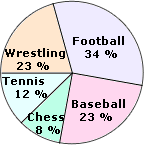
A. 800
B. 850
C. 900
D. None of the above
Step: 1
Let y
Step: 2
Write a proportion.
Step: 3
[Substitute.]
Step: 4
[Write the cross products.]
Step: 5
= 850
[Multiply.]
Step: 6
850 out of 2500 students like football.
Correct Answer is : 850
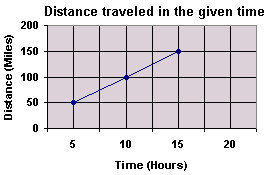
A. Greater than 250 mi
B. Greater than 100 mi
C. Greater than 200 mi
D. Greater than 150 mi
Step: 1
From the graph, the distance that Justin covers is increasing in each hour.
Step: 2
The distance that Justin covers in 15 hours is 150 mi.
Step: 3
So, one would expect the distance that Justin covers in 20 hours to be certainly greater than 150 mi.
Correct Answer is : Greater than 150 mi
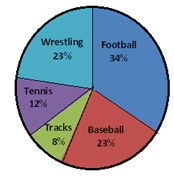
A. 500
B. 420
C. 460
D. None of the above
Step: 1
Let y
Step: 2
Number of people who like wrestling out of 100 people / Total number of people = Number of people who like wrestling out of 2000 people / Total number of people
Step: 3
= 23 100 y 2 0 0 0
[Substitute.]
Step: 4
[Write the cross products.]
Step: 5
= 460
[Simplify.]
Step: 6
460 out of a population of 2000 people like wrestling.
Correct Answer is : 460
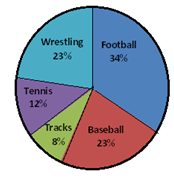
A. 320
B. 360
C. 340
D. None of the above
Step: 1
Let y
Step: 2
Number of people who like football out of 100 people / Total number of people = Number of people who like football out of 1000 people / Total number of people
Step: 3
= 34 100 y 1 0 0 0
[Substitute.]
Step: 4
[Write the cross products.]
Step: 5
= 340
[Multiply.]
Step: 6
340 out of a population of 1000 people like football.
Correct Answer is : 340
A. 420
B. 40
C. 300
D. 320
Step: 1
Let x
Step: 2
Total number of students in the school = 600
Step: 3
Step: 4
So, 320 students in the school prefer dance class to music class.
Correct Answer is : 320
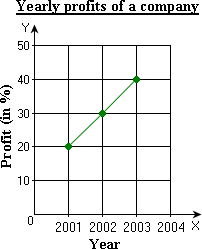
A. 60 %
B. 40 %
C. 55 %
D. 50 %
Step: 1
Prediction means telling what would happen in the near future.
Step: 2
The graph shows an increasing trend in the profit earned by a company (in percent) during the last three years by 10% .
Step: 3
The profit earned by the company (in percent) in the year 2004 is 50%
Step: 4
So, it can be predicted that the profit earned by the company(in percent) for the year 2005 would be 60% .
Correct Answer is : 60 %
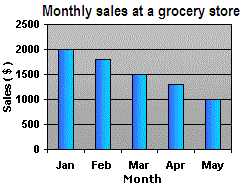
A. more than $1,000
B. less than $1,000
C. more than $2,000
D. less than $10,000
Step: 1
The sales have been decreasing each month.
Step: 2
Sales in the month of May are $1,000.
Step: 3
So, one would expect the sales in June to be less than $1,000.
Correct Answer is : less than $1,000
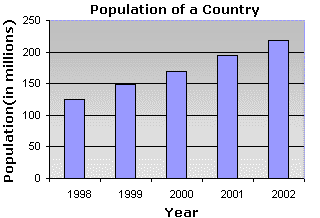
A. more than 300 million
B. about 200 million
C. about 260 million
D. less than 200 million
Step: 1
From the bar graph, the difference in the population of a country in succeeding years is 50%.
Step: 2
So, the population in the year 2003 would be about 260 million.
Correct Answer is : about 260 million
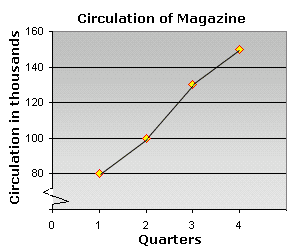
A. about 150,000
B. less than 160,000
C. less than 100,000
D. about 180,000
Step: 1
The given graph shows the circulation of a magazine (in thousands) in the year 2004.
Step: 2
The circulation of the magazine in the first quarter of 2004 will be about 180, 000.
Correct Answer is : about 180,000
A. 450
B. 225
C. 300
D. 150
Step: 1
Among 150 people, 75 preferred rock music.
[Given]
Step: 2
That means half of the people preferred rock music.
[As 75 is half of 150.]
Step: 3
So, 300 people out of 600 could be predicted to prefer rock music.
[As 300 is half of the 600.]
Correct Answer is : 300
A. 8
B. 4
C. 2
D. 6
Step: 1
Number of Toys checked = 500.
Step: 2
Number of Toys found to have defective = 10.
Step: 3
Probability of a Toys to have defective out of 100 = 1 0 5 0 0 N u m b e r o f f a v o u r a b l e e v e n t s T o t a l n u m b e r o f p o s s i b l e o u t c o m e s
Step: 4
[Simplify]
Step: 5
Number of Toys to have defective out of 200 magazines = 200 × 1 5 0
Step: 6
= 4.
[Simplify]
Correct Answer is : 4
A. 6
B. 36
C. 360
D. 42
Step: 1
Number of T-shirts manufactured every week = 6000.
Step: 2
Number of T-shirts checked = 100.
Step: 3
So, the probability of getting a defective T-shirt = 6 1 0 0
[Number of favorable events Total number of possible outcomes.]
Step: 4
= 3 5 0
Step: 5
Therefore, the number of T-shirts that can have defects in each week of the production = 6000 × 3 5 0
[Simplify.]
Step: 6
= 360
Correct Answer is : 360
- Probability of an Event Represented by a Number From 0 to 1-Gr 7-Solved Examples
- Possible Outcomes-Gr 7-Solved Examples
- Identifying Equally Likely Outcomes-Gr 7-Solved Examples
- Likelihood of an Event-Gr 7-Solved Examples
- Probabilities of Compound Events-Gr 7-Solved Examples
- Making Inferences from Data of Two Populations-Gr 7-Solved Examples
Related Worksheet
- Data